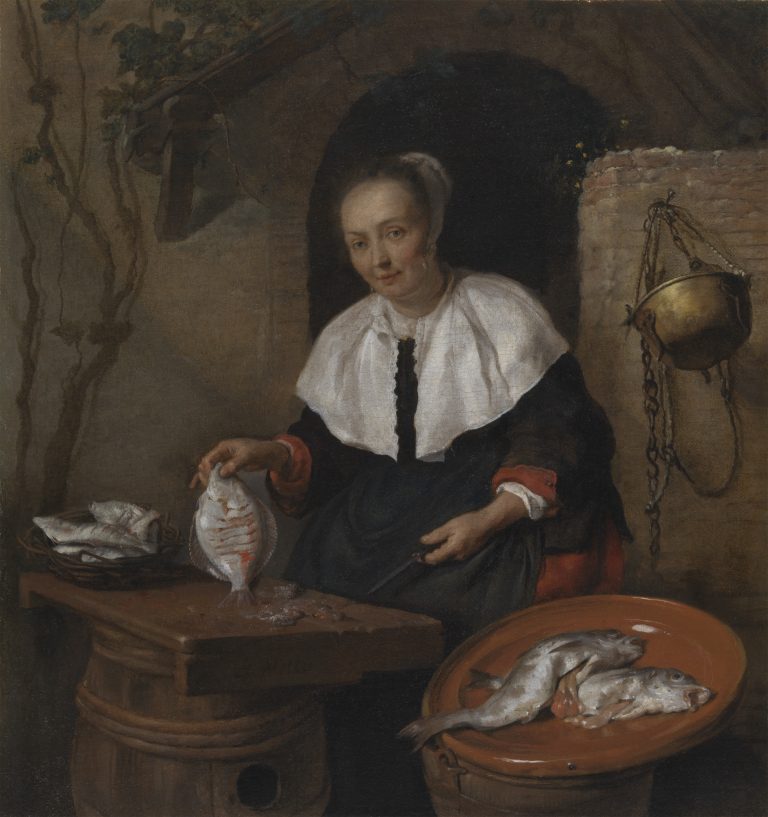In the mid-1650s, soon after he moved to Amsterdam, Gabriel Metsu painted four works in which an attractive young woman is shown handling fish or vegetables in front of a brick house.1 In Woman Cleaning Fish, the woman smiles sensually toward the viewer as she displays a plaice (flatfish) that she is about to clean with her knife. Judging from the other plaice in the wicker basket on her wooden table, the two large fish displayed on a large earthenware platter, and the set of scales hanging from a brick wall, the woman must be a fish vendor, even though she is respectably outfitted in a black dress with a large white linen collar.2
Woman Cleaning Fish belongs to a long tradition of images of female food sellers and maids at work that stretches back to the market and kitchen scenes that Pieter Aertsen (1507/08–75) and his pupil Joachim Beuckelaer (ca. 1534–ca. 1574) painted in the mid-sixteenth century. These artists represented attractive young women in the presence of a cornucopia of meat, fowl, fish, and vegetables, usually with a small biblical episode in the background. The seductively displayed foods in the foreground in Aertsen’s and Beuckelaer’s works symbolize the voluptas carnis and function as an antithesis to the scriptural narrative of the background scene.3 When Metsu depicted food vendors, he omitted the biblical narratives, but through pose and gesture he often alluded to the sexual connotations of women and food found in these earlier prototypes.4
A number of Dutch artists depicted female vendors of food, and it is instructive to compare their varied approaches to the subject. The most prolific painter of outdoor market scenes was Hendrick Martensz Sorgh (1609/11–70) from Rotterdam, who generally represented the hustle and bustle of urban markets in which female vendors and shoppers haggle over the price of fish and vegetables.5 More direct visual prototypes for Metsu’s female food vendors are to be found in the work of artists from Metsu’s native Leiden, particularly Gerrit Dou (1613–75) and Frans van Mieris (1635–81). For example, Dou’s The Pancake Baker (fig 1) from the early 1650s (Galleria degli Uffizi, Florence) and Van Mieris’s Fruit Seller of ca. 1655 (British Royal Collection) both focus on a single vendor in a quiet, rustic location.6 Much like Metsu, Dou and Van Mieris placed their female vendors before an open door of a rustic brick house overgrown with vines. Nevertheless, a different relationship exists between the viewer and these scenes than in Woman Cleaning Fish. In the paintings by Dou and Van Mieris, the viewer merely observes the financial transaction between the vendor and her customer, whereas in Metsu’s painting the viewer is the object of the vendor’s attention.
The direct gaze and attractive appearance of the woman in the Leiden Collection painting relates to other subject types that Dou painted during the late 1640s and early 1650s that Metsu would have known, since he was still living in Leiden at that time. For example, Dou depicted young kitchen maids and shop vendors at open windows enticing the viewer to purchase their wares. As if their bare arms and visible cleavage were not enough to make them look desirable, Dou usually also included hares, poultry, carrots, or other objects to emphasize their sexuality. In one such painting, A Maid and Boy Enframed (Staatliche Kunsthalle, Karlsruhe) (fig 2), the woman vendor lifts up a fish in a manner similar to that seen in Metsu’s painting.7 Another of Dou’s paintings of a seductive young kitchen maid that Metsu may have known (now lost but known through a copy by Van Mieris) is A Young Woman Gathering Water from a Well (fig 3).8 Not only is the setting, including a brick wall attached to the house, similar to that of Woman Cleaning Fish, but the fruit on the makeshift table similarly alludes to the woman’s fertility.9 In each of these works the woman has directed her attention to the viewer.
Metsu’s Woman Cleaning Fish draws upon Dou’s and Van Mieris’s market scenes and their images of seductive kitchen maids, but he conceived this work in a direct and appealing manner uniquely his own. Although the woman in Metsu’s painting has a warm and inviting smile that suggests that her fish are not the only thing on offer, the sexual allure is understated because of the woman’s respectable attire. Metsu must have enjoyed commercial success with this approach, given that he painted variations of the subject four different times soon after he moved to Amsterdam. Only one Dutch artist from later generations followed Metsu in this approach: Godefridus Schalcken (1643–1706), whose Woman Holding a Herring from 1685–90 seems indebted to Metsu’s vendors.10 Eighteenth-century watercolorists also took an interest in Metsu’s market scenes. The Amsterdam artist Anna de Frey (ca. 1775–1808), for example, copied Woman Cleaning Fish in 1804.11
